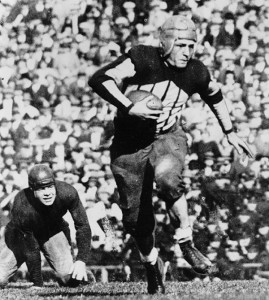Red Grange: The Galloping Ghost
The October Sports Then and Now Vintage Athlete of the Month was the NFL’s first superstar and marquee attraction.
The NFL was less than five years old and struggling to gain a foothold in popularity when Red Grange put the league on the map during a 67-day, 19-game, barnstorming tour that is credited with legitimizing professional football and the NFL.
Born in Forksville, Pennsylvania and raised in Wheaton, Illinois, Grange’s athletic talents were cultivated in high school when he was a four-year letter winner in football, basketball, baseball and track. He scored 75 touchdowns (532 points) in football and as a junior led Wheaton High School to an undefeated record and state title. He was the 1920 state high school high jump champion, won the long jump and 100-yard dash in 1921 and in 1922 won the state championship in the 220-yard dash.
To help support his family, Grange took on a part-time job working as an ice toter for $37.50 per week. The job helped develop his core strength and also earned him the nickname the “Wheaton Ice Man.”
Originally planning to play only basketball and track at the University of Illinois, Grange soon found his way onto the football field. In his first collegiate game, Grange scored three touchdowns against the University of Nebraska. He played in seven games as a sophomore and finished with 723 yards rushing and 12 touchdowns as Illinois went undefeated and was recognized by several entities as the National Champion.
He became a national icon on October 18, 1924 when the Illini opened their new War Memorial Stadium against the undefeated Michigan Wolverines. Grange took the opening kickoff 95 yards for a touchdown and before the first quarter was over had also scored on touchdown runs of 67, 56 and 44 yards. He later scored a fifth touchdown on another kickoff return as the Illini drubbed the Wolverines 39-14.
Watching the young star, legendary sportswriter Grantland Rice penned the following poetic description:
A streak of fire, a breath of flame
Eluding all who reach and clutch;
A gray ghost thrown into the game
That rival hands may never touch;
A rubber bounding, blasting soul
Whose destination is the goal — Red Grange of Illinois!
In an era before television and sports talk radio, Rice was the predominant sportswriter in America with his words published in newspapers across the country. His portrayal of Grange helped establish him as the leading figure in college football. While Rice was the first writer to refer to Grange as a “ghost”, it was Chicago sportswriter Warren Brown who ultimately dubbed him the “Galloping Ghost.”
As a senior in 1925, Grange rushed for a career-high 237 yards and accounted for 363 yards of total offense as Illinois upset the University of Pennsylvania 24-2.
Amazingly, in just 20 college football games, Grange rushed for 3,362 yards, caught 14 passes for 253 yards and completed 40 of 82 passes for 575 yards. He scored 31 career touchdowns, recording at least one in every game except a 1925 loss to Nebraska. Of his 31 scored, 16 were of at least 20 yards and nine were on plays of 50 or more yards.
In the 1920s college football was extremely popular and well respected, but professional football was struggling for legitimacy and a mainstream audience. The American Professional Football Association (which in 1922 was renamed the National Football League) began operations in 1920, but was a revolving collection of teams across the Northeast and Midwest.
The league needed a star who could help bring the excitement and validation needed if the league was going to survive.
Unlike today when college seniors wait until the next season and are drafted into the NFL, in 1925 Grange was eligible to sign a professional contract and start playing immediately.
Coveted throughout the league, Grange eventually signed with George Halas and the Chicago Bears. It proved to be a pivotal moment for Halas, Grange and the NFL.
Halas organized a 67-day barnstorming tour that included 19 games at a variety of locations. Grange signed the contract, which included a salary and percentage of the gate receipts and ultimately paid him roughly $100,000 (the average player salary was $100 per game), the day after his final game at Illinois.
On December 6, 1925 more than 65,000 people crowded into the Polo Grounds in New York City to watch Grange and the Bears play the New York Giants in a game that helped financially save the Giants franchise. Grange scored a touchdown on a 35-yard interception return, rushed for 53 yards, caught a 23-yard pass and completed two of three passes for 32 yards.
Grange split from Halas and the Bears in 1926 to form the American Football League, but in 1927 Grange and his team the New York Yankees briefly joined the NFL. He suffered a serious knee injury in a game against the Chicago Bears that forced him to miss the entire 1928 season as the Yankees folded.
Returning to the Bears in 1929, Grange remained with the team through the 1934 season playing defensive back and halfback. He was a first team All-Pro in 1930 and 1931 and helped lead the Bears to NFL Championships in 1932 and 1933.
His number 77 was retired by the University of Illinois in 1925 and he was inducted into the College Football Hall of Fame in 1951. Grange served as a television broadcaster for college and professional football games for many years and in 1963 was a charter inductee into the Pro Football Hall of Fame.
Grange passed away in 1991 at the age of 87.












